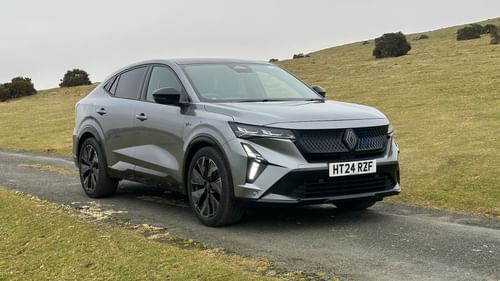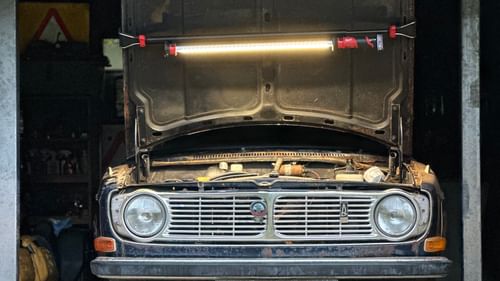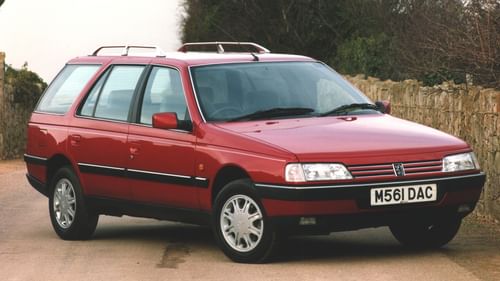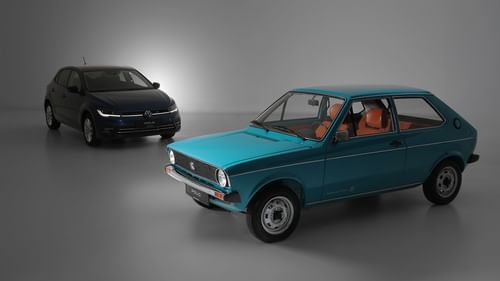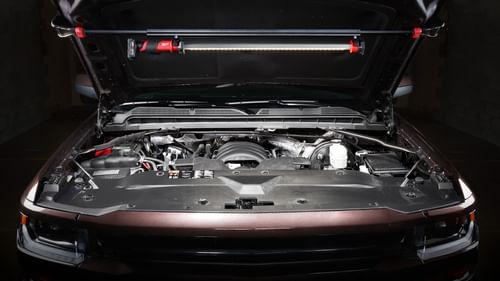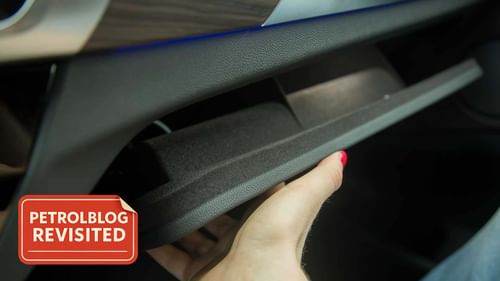Golf Crazy: New Peugeot 308
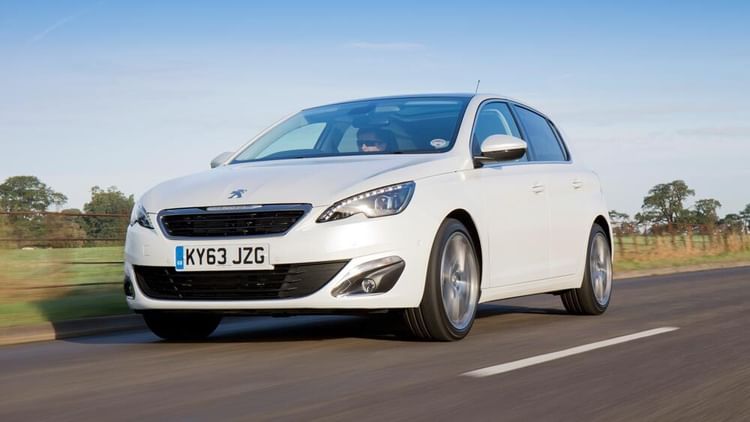
Make no mistake - Peugeot is obsessed with playing Golf. In producing the all-new Peugeot 308, the French firm not only benchmarked the Volkswagen Golf, it set out to beat it. Other firms have tried - and failed - in the past to produce a genuine Golf rival, but few have been as obsessed as Peugeot.
Whatever you may think of the modern Volkswagen Golf, it remains the benchmark for buyers and manufacturers alike. Some of that may be down to marketing and solid branding, but it's also because the Golf is annoyingly competent.
During the development of the new 308, Peugeot actually put a new Volkswagen Golf - and an Audi A3 for that matter - through the same pre-launch quality control tests. These tests amounted to 2.5 million kilometres and 2,500 hours - some using robots and others using 1,000 test drivers. Peugeot's single-minded ambition - to make the Peugeot 308 feel like new after three years of use.
Or at least to make it retain the same level of quality as an Audi A3 or Volkswagen Golf after 36 months of normal motoring. To anyone unfamiliar with Peugeot of old, this may seem laughable, especially given the issues of the past 15 to 20 years. But to PetrolBlog, this is merely an example of Peugeot re-establishing what made it great.
Need an example of Peugeot's OCD levels of commitment to making a car that isn't a Golf, feel like a Golf? How about the robot which was employed to do nothing other than slam down a 308's tailgate a total of 6,000 times. And when done, this tailgate was put on a production-ready 308 and subjected to a road test on cobbled streets, the kind of which would be familiar to residents of Bruges.
When Peugeot discovered a rattling sound - eventually traced back to the metal clips securing the inner boot liner - the team replaced the clips with torqued-in screws. The result - no rattles. Peugeot 308 owners will thank that tailgate-slamming robot in three years time.
But Peugeot will need more than just a rattle-free tailgate to take on the Germans. In fact, the 308 must deliver on its 'unquestionable quality', 'game-changing standards' and 'best-in-class interior', as promised by the Peugeot UK team. Bold claims - there's no room for manoeuvre here...
And you know what? The Peugeot 308 may just pull it off. It's really very, very good...
Peugeot has managed to do what it failed miserably to do with the current 308 and the 307 - make the new 308 visually appealing. The new Peugeot 308 looks like a natural successor to the 306 and as far as PetrolBlog is concerned, that's a very good thing. If only Peugeot had the courage to go back to the future and dust off the 306 badge.
The styling works especially well with the LED headlamps - available on Allure and Feline models - but overall there's nothing particularly noteworthy to say about the 308's looks. It's just an example of a simple and pure design - again, another hark back to Peugeots of old.
Only one question mark remains over the exterior styling and that's whether or not the new Peugeot 308 has lost some of its 'Frenchness'. In creating a genuine rival to the Golf, has Peugeot ditched the French Mustard in favour of something altogether more German? More bratwurst than brioche? Well if you can't beat 'em, join 'em. Just beware you don't become something you detest.
In truth, the same question mark could overshadow what's an otherwise first-rate interior. The inside of the new Peugeot 308 is a triumph of concentrating on the areas that matter the most. All of the traditional driver touch-points are delivered with precision, quality and style. It's the little things like the leather used on the compact steering wheel and the weight of the interior door handles.
The 9.7-inch touchscreen infotainment system - standard on the Active, Allure and Feline - has all the quality and intuitiveness of a high-end tablet device. Some may bemoan the fact that the vast majority of the 308's controls are now found on a touchscreen unit, but when it works as well as this, it doesn't matter. Let's just hope Peugeot employed a robot to simulate three years of sticky fingers and 'critical errors'.
In its entirety, Peugeot calls the 308's interior the i-Cockpit - four integrated components consisting of the steering wheel, a 'head-up' instrument panel, a high centre console and the aforementioned touchscreen. Fancy and whimsical name aside, it works. The dials are clear, the touchscreen is easy to use and the switches have a proper premium feel to them.
Doubts still remain over whether everyone will feel comfortable with the compact steering wheel and the requirement to look over, rather than look through the wheel at the dials, but if you can find a good driving position, you'll love it. And it's also fair to say that whilst the key touch-points ooze quality, things aren't so good when you delve a little deeper. The quality of the panel below the touchscreen for example, it just feels a little low-rent.
It's at this point that it's worth mentioning that we only managed to test the top-spec Feline models on the UK launch and with prices starting at £20,995 for the flagship 308, you'd have every right to expect your C-segment hatchback to feel special. Much will depend on how good the less well endowed Access, Active and Allure trim levels actually feel.
How the Peugeot 308 performs out on the road really comes down to which engine you decide to choose.
On the basis of a short and often congested test route around Hampshire, the 115bhp 1.6-litre e-HDi feels woefully short of power, to the point where it's almost impossible to recommend the 92bhp version of the same engine. The diesel engine feels lethargic and completely lacking in poke, making overtaking and motorway slip roads a bit of a gamble.
Far more impressive is the 156bhp version of the brilliant 1.6-litre THP petrol unit, as tested before in the likes of the Citroën DS3 Cabrio, Peugeot 208 GTi and Peugeot 308 CC (some with the uprated 200bhp output). With the petrol engine, the 308 feels more willing, more engaging and lighter.
And that's no coincidence. Compared with the current 308, the new model is a whole 140kg lighter, with 70kg saved by using the new EMP2 modular platform and the remaining 70kg saved by using lightweight components. One example is the new composite tailgate, constructed using Thermoplastic, reducing the overall weight by 3kg. Something that tailgate-slamming robot will be happy about.
Once out on the road, the new Peugeot 308 feels infinitely more satisfying to drive than the current model. The ride quality is top notch (very French!) and the steering weights-up nicely at higher speeds. Yes, the fully electric power steering is lacking in feel, but the turn-in is sharp and direct. It's just a shame that the imprecise and loose-feeling six-speed gearbox is too keen to play the role of party-pooper.
On a road like the A272 - where we simply had to divert from the pre-arranged test route to have a play - the 308 loses some ground on its rivals, with more than a hint of body-roll and a tendency to feel a little unsettled over rutted surfaces, making a rival like the SEAT Leon SC feel like a better option. That said, we were testing the FR model, so we'll reserve judgement on the 308 until the GT, GTi or even the 308 R versions arrive.
And we'll reserve making a conclusive judgement on the new Peugeot 308 until we get a chance to do a thorough road test review in 2014. But on the basis of a few hours in Hampshire, the new 308 is a credible alternative to the Golf. At 470 litres of luggage space, it offers 90 litres more than the MK7 Volkswagen Golf, though some of this boot space does come at the expense of room in the back seats, with head- and leg-room feeling a bit restrictive for rear seat passengers.
It's also worth noting that in spring 2014, the Peugeot 308 range will be boosted by the arrival of a 82g/km CO2 1.6-litre BlueHDi diesel engine. That's quite a remarkable CO2 figure and whilst we won't expect fireworks from the performance of the 120bhp unit, it promises to drink less than a vicar at a tea party.
Which Peugeot 308 should you buy? Well visibility out the back is so bad you'll need to opt for either the Allure or Feline, both of which feature a reversing camera as standard. And even putting aside PetrolBlog's natural bias towards the petrol engine, you can't look further than the 1.6 THP, and that's not available on anything other than the Allure or Feline.
So that's settled, go for the Peugeot 308 Allure with the 1.6 THP engine. At £19,745, it's significantly more than the £14,995 headline price, but still strong enough value to warrant your attention alongside the Golf and even the Audi A3.
If you were looking to buy a new Volkswagen Golf this Christmas, it's highly unlikely that you'll change your mind and opt for the Peugeot 308. But if you had a list of three family hatchbacks to consider, you really should include the 308 as one of the three.
Right now, PetrolBlog would narrow it down to a straight fight between the Leon and the 308. Both are better looking than the Golf, better value than the Golf and feel fresher than the Golf. Choices, choices...
But the good news is, the Peugeot 308 is back in the running. And that's an immensely satisfying thing to say on PetrolBlog...
Edit: for the full review of the 2014 Peugeot 308 Feline, click here.
Images © Peugeot and Volkswagen.






